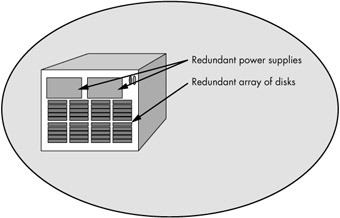The NAS Server
The NAS server (see Figure 20-4) stores all data used by the cluster legacy applications and the Thin Clients, and it can run a lock manager (discussed in Chapter 16) that can be said to reside at the data tier to arbitrate business tier object access to data. (If all of the shared data is stored in a database management system, the DBMS may act as the lock arbitrator at the data tier instead of the lock manager running on the NAS device.)

Figure 20-4: High-availability NAS server
The NAS server will normally connect to the Ethernet backbone using one or more high-speed connections and may provide enough redundancy of critical components (power supply, fans, disks, and so on) in a single enclosure to eliminate worry about a second NAS device for high availability.
High-Availability NAS Server
As shown in Figure 20-4, your highly available NAS server will use RAID drives to eliminate the disk drives as a single point of failure. Not shown in Figure 20-4 is the network connection used by the NAS device. Normally, a mission-critical NAS configuration will also use two physical connections to the Ethernet backbone and thus eliminate the network connection as a single point of failure.
| Note | A second NAS server is required at another location for disaster recovery. |
Storing your data centrally makes it easier to back it up, allows you to create online snapshots, gives you the ability to grow volume sets without reformatting disk drives as disk space requirements grow and lets you use a vendor-supplied data replication system for creating a disaster recovery site.[3]
[3]Many, if not all, of these functions can be built using open source software such as RAID, LVM, and the rsync program (rsync was discussed in Chapter 4). Describing how to build a NAS server and how to implement disaster recovery data replication is outside the scope of this book.
EAN: 2147483647
Pages: 219